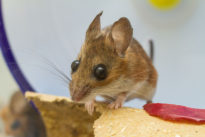 They may make subway riders shudder, but New York City mice are the stars of a cool new paper outlining their evolutionary history during a rapid period of urbanization. Scientists from the City University of New York used ddRAD-seq to genotype 23 populations of white-footed mice, Peromyscus leucopus, in the metropolitan area.
They may make subway riders shudder, but New York City mice are the stars of a cool new paper outlining their evolutionary history during a rapid period of urbanization. Scientists from the City University of New York used ddRAD-seq to genotype 23 populations of white-footed mice, Peromyscus leucopus, in the metropolitan area.
The publication, “Urbanization shapes the demographic history of a native rodent (the white-footed mouse, Peromyscus leucopus) in New York City,” came out in the Biology Letters journal of the Royal Society (subscription required, or check out this preprint). Lead author Stephen Harris and collaborators used the genotyping results to explore population dynamics and genomic diversity in these mice. “This study is the first to examine the impact of urbanization on demographic history using patterns of genomic variation in wild populations,” the authors write.
They found that urbanization had a major role in shaping the evolution of P. leucopus, as did climate change. “We detected bottlenecks immediately after isolation of urban populations, suggesting that a small remnant population within these parks at the time of the bottleneck provided most of the urban genetic variation found today,” Harris et al. report. In addition, they found that white-footed mice colonized Long Island shortly after the retreat of a glacier that covered it some 21,000 years ago, and that those populations were then isolated after a rising sea level separated the region from the mainland.
The team analyzed nearly 15,000 SNPs from more than 190 mice. “We assigned individuals to evolutionary clusters and then inferred recent divergence times, population size changes and migration,” the authors write, noting that population divergence timing maps closely to the urbanization pattern in New York. The team used Pippin Prep to perform automated size selection, an important step in the ddRAD-seq protocol.
“Our results show that geography, geological events and human-driven habitat change have left a detectable genomic signature in NYC’s white-footed mouse populations,” the scientists conclude.





